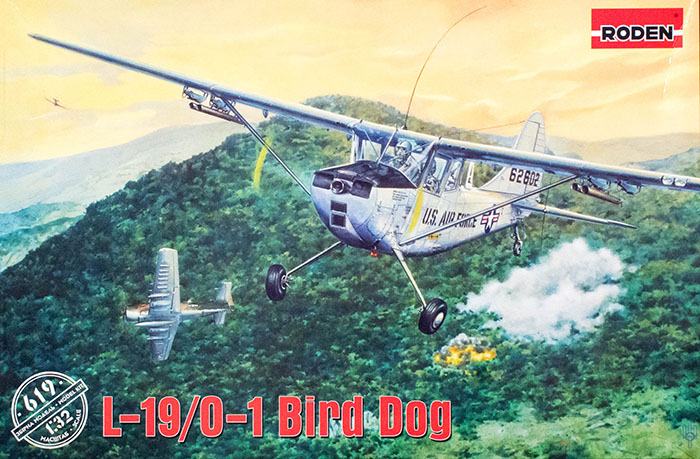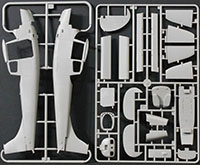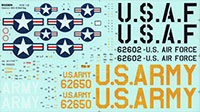
Roden 1/32 L-19/O-1 Bird Dog Kit First Look
By Michael Benolkin
| Date of Review | December 2016 | Manufacturer | Roden |
|---|---|---|---|
| Subject | L-19/O-1 Bird Dog | Scale | 1/32 |
| Kit Number | 0619 | Primary Media | Styrene |
| Pros | Nice details | Cons | See text |
| Skill Level | Experienced | MSRP (USD) | $59.99 |
First Look
 |
 |
 |
 |
After the end of World War Two in 1945 and after the Air Force became a separate service in 1947, the Army wanted a more robust observation aircraft that could be used for artillery spotting, reconnaissance, and liaison flights into unimproved areas. The aircraft selected for the job was the Cessna 305A. This design was essentially a Cessna 170 with a narrowed fuselage to accommodate a crew of two in tandem seating (the only tandem-seated aircraft made by Cessna). You'll see a variety of designations for this aircraft, the US Army called it the L-19, the US Marine Corps called it the OE-1. When aircraft designators were standardized across all US military branches, these were all redesignated as O-1.
The Cessna 305A (L-19 Bird Dog in Army service) was powered by a 213hp Continental engine turning a huge propeller optimized for climb performance. The L-19 could climb like a homesick angel, but wasn't going anywhere fast with a 100 knot cruise speed. The Bird Dog saw first combat over Korea, and once again over Southeast Asia. Because of inter-service politics, Army Aviation was transformed into a rotary-wing-only force and its fixed-wing aircraft, including the Bird Dogs, were turned over to the Air Force. About the same time, the DoD directive standardizing military designations turned the L-19 into the O-1 Bird Dog. Air Force crews used the Bird Dog over Southeast Asia as Forward Air Control (FAC) platforms to guide the fighter-bombers onto targets that the FACs would observe below. As enemy air defenses improved, the Bird Dog quickly became increasingly vulnerable to ground fire and was replaced by progressively faster observation aircraft.
When Roden announced they were developing the L-19 Bird Dog and O-2 Skymaster in 1/32 scale, many modelers (including me) were quite pleased. Until now, the only Bird Dog kits produced were the Airfix 1/72 and the Model USA 1/48 examples. Unlike the previous examples, Roden provided some nice details and options in this kit but also made a few mistakes along the way.
The kit is molded in light gray styrene and presented on seven parts trees plus one tree of clear parts. The first mistake is that Roden packaged the clear parts in the same bag as the other parts leaving them vulnerable to scratches. Among the features and options in this kit:
- Nicely detailed Continental engine
- Positionable cowling panels
- Nicely detailed cockpit with sticks, throttle quadrants, and rudder pedals for the front and rear seats
- Nicely detailed instrument panel but no instrument face details
- Positionable cockpit entry door and window
- Positionable rudder
- Positionable elevators
- Positionable ailerons
- Separately molded flaps but no hinges provided for extended flaps
- Eight loaded white-phosphorous rocket tubes provided for mounting under the wings
The sizable decal sheet provides marking options for two aircraft:
- L-19, 56-2650, US Army Training School, Fort Rucker, 1965
- O-1E, 56-2602, Da Nang AB, USAF, 1966
While the kit has some nice details and they did a nice job of keeping ejector pin marks out of the cockpit interior, there are some things that will need to be addressed to build a nice model of this aircraft:
- You might be satisfied simply painting the instrument faces black and calling it a day, but you might obtain some AirScale 1/32 generic instrument faces and populate the panel properly. In this scale, you'll see the difference.
- You'll want to find some good Bird Dog interior photos to replicate the various placards around the cockpit and you might even want to add the battery and radio gear as well.
- The upper wing half is molded as one piece but the top surface near the trailing edge has troughs for sink marks that will need to be filled.
- The cockpit lacks crew restraints so you'll need to go to the aftermarket for shoulder harnesses and lap belts.
- The decal options are rather generic and hopefully we'll see some aftermarket options, but in the meantime, Roden didn't seem to know what to call the aircraft. In the decals and instructions you'll see the data placard for both the US Army and USAF designate the aircraft 'L-19 O-1E'. The placards are small enough that few will notice but the AMS modeler will want to remove the incorrect designator for that subject with an X-Acto knife.
- Roden provides wire rod for the VHF antennas on the horizontal stab leading edge as well as the whip antenna over the cockpit. You might consider using a different material that has some give/flex instead.
- If you're modeling the aircraft ready to fly, the loaded Willy-Pete tubes are just fine and you can add an M16 and other items to the cockpit interior for an aircraft operating in Southeast Asia. You can alternatively replace the loaded tubes with styrene or brass tubes trimmed to replicate the rocket launchers in order to pose the aircraft with expended ordnance, or simply use the 'pylons' (parts 3D) and leave off the tubes altogether for a training alternative.
- If you wish to pose the flaps extended, remember these are Fowler flaps and did not rotate downward like early Cessnas. They extend aft and down so you'll need to fabricate your own extended hinges for the job.
This is a nice-looking model that, in spite of the notes above, really turned out well and hopefully we will see some additional subjects appear in the aftermarket soon. In the meantime, I have my two kits in the queue and I'm looking forward to revisiting an old friend I had the privilege to fly many years ago.







